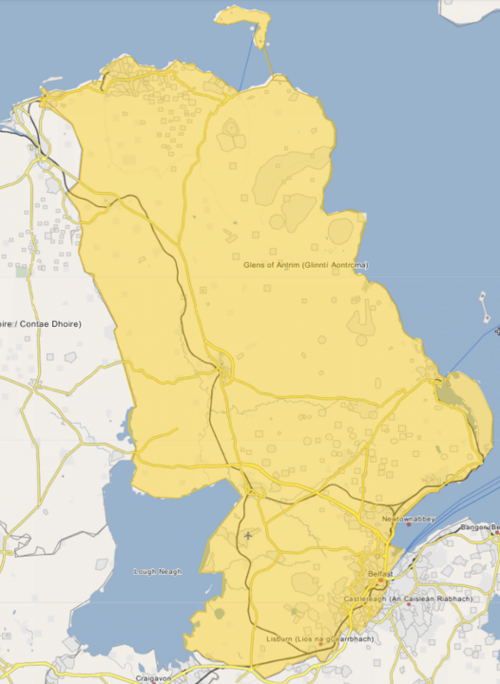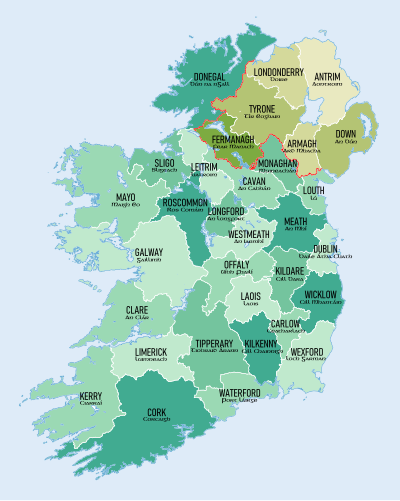Abbreviations and key
| * | current monastic function |
|---|---|
| + | current non-monastic ecclesiastic function |
| ^ | current non-ecclesiastic function |
| = | remains incorporated into later structure |
| # | no identifiable trace of the monastic foundation remains |
| ~ | exact site of monastic foundation unknown |
| ø | possibly no such monastic foundation at location |
| ¤ | no such monastic foundation |
| ≈ | identification ambiguous or confused |
Locations with names in italics indicate probable duplication (misidentification with another location) or non-existent foundations (either erroneous reference or proposed foundation never implemented).
| NIEA | Scheduled Monument (NI) |
| NM | National Monument (ROI) |
| C.I. | Church of Ireland |
| R.C. | Roman Catholic Church |

(approx.)
(approx.)
(site)
(approx.)
(approx.)
(approx.)
(approx.)
(approx.)
(approx.)
| Foundation | Image | Communities & provenance | Formal name or dedication & alternative names | References & location |
|---|---|---|---|---|
| Aghnakilla Monastery ø | supposed early monastery dissolved before 11th century | Achad-cinn; Achad-na-cille; Aughnakeely | [1] [2] 54°54′34″N6°23′41″W / 54.9094°N 6.3948°W (approx.) | |
| Antrim Monastery |  | Gaelic monks possibly founded by St Comgall of Bangor; plundered 824; plundered 1018; destroyed 1147 | Oen-truib; Aen-truib; Aentreb; Aontruibh; Eantrobh; Oentrebh | [3] 54°43′26″N6°12′32″W / 54.7240°N 6.2089°W |
| Ardclinis Friaryø | tradition of house of Franciscan Friars, Third Order Regular — evidence lacking | [4] 55°03′23″N6°00′40″W / 55.056464°N 6.011216°W | ||
| Armoy Monastery ø |  | supposed early monastery, founded by St Olcan; dissolved before 11th century | Airthir-maige; Domnach-; Ethirmoy | [5] [6] 55°08′05″N6°18′38″W / 55.1347182°N 6.3106157°W |
| Ballycastle Friary ≈ | building called 'abbey', apparently built 1612 by Randal Mac Donnell, Earl of Antrim; standing until the Reformation; probably Bonamargy Friary (v. infra) | |||
| Ballyprior Priory | Premonstratensian Canons — from Woodburn (community founded at Woodburn before 1326); transferred here 1542-3; dissolved after 1565 | Magee Island Priory | [7] [8] 54°50′05″N5°44′25″W / 54.83483°N 5.74033°W | |
| Bonamargy Friary, Ballycastle |  | Franciscan Friars, Third Order Regular founded c.1500 (c.1475) by Rory MacQuillan, Lord of Reute (or Mac Donell); dissolved 1584; burned 1589; granted to the descendants of the founder Franciscan Friars, First Order Regular repaired & re-occupied at the petition of Father Conor Mac a'Bhaird, as a rest centre for missionaries 1626–1642, restored 1931; (NIEA) | Bunanmargaigh | [9] 55°12′07″N6°13′52″W / 55.202°N 6.231°W |
| Carrickfergus Abbey | Premonstratensian Canons daughter house of Dryburgh; priory founded before c.1183; raised to abbey status 1212; dissolved after 1320-6; succeeded by Woodburn (v. infra) | |||
| Carrickfergus Friary # | Franciscan Friars Minor, Conventual founded 1232–48 by Hugh Lacy, Earl of Ulster; Observant Franciscan Friars reformed 1497; dissolved 1540; restored by Queen Mary 1557; friars expelled 1560; granted to Sir Edmund Fitzgerald, who assigned it to Sir Arthur Chichester, who built a castle on site 1610; used as a munitions store, rebuilt as Joymount House 1618; new house built by friars 1626 | Carrac-fergusa; Cragfargas; Gracfergos; Grafergosensis | 54°42′56″N5°48′19″W / 54.7154476°N 5.8053732°W | |
| Church Island Monastery, Lough Beg | 54°47′24″N6°29′05″W / 54.7899659°N 6.4847527°W | |||
| Church Island Abbey, Lough Beg | ||||
| Clondrumalis Abbey ~≈? | Premonstratensian Canons, possibly located in County Antrim, possibly Woodburn | Woodburn? | ||
| Cluain Monastery ø+ | supposed early monastery founded by St Oclan; dissolved before 11th century; C.I. parish church built on site | Kilcluain; Cell-chluaine | [10] | |
| Connor Monastery | church probably founded early 6th century by Mac Nissi (St Macnisse) (Oengus or Coemahan Breac); episcopal diocesan cathedral; diocese united with Down 1453 | Coinnere; Condere; Coinnee | [11] 54°48′26″N6°12′45″W / 54.8072928°N 6.2123866°W | |
| Cranfield Monastery | early monastic site, patron St Eoghan; by tradition the burial place of St Olcan | Maigi Cremc; Cremh-caille; Ecclesiaa de Crewill | [12] [13] [14] 54°42′15″N6°21′49″W / 54.70411°N 6.36374°W | |
| Culfeightrin Monastery ø | supposed early monastery founded 5th century by St Patrick; dissolved before 11th century | Culechtrann; Kilfeutre; Magherintemple | [15] [16] 55°11′32″N6°12′44″W / 55.19222°N 6.21210°W | |
| Drumeeny Monastery ø | supposed early monastery early monastic site, monks; founded 5th century by St Patrick, who left bishop Enan in charge; dissolved before 11th century | Druim-findich; Druim-indeich; Druim Findich, Enán in; inDruim [Fh]indich, Enán; Ecclesia de Drum-Indich; Killeena Gobbin's Heir Castle | [17] [18] [19] [20] 55°10′59″N6°13′19″W / 55.18309°N 6.22188°W | |
| Druim La Croix Abbey | Premonstratensian Canons daughter house of Dryburgh; founded before c.1250; dissolved after 1320-6; succeeded by Woodburn (v. infra) | Druim La Croix; White Abbey | [21] 54°40′05″N5°54′30″W / 54.66811°N 5.90831°W | |
| Drumtullagh Monastery | grange founded 5th century by St Patrick | Telagh-Ceneoil-Oingusa; Tulach | [22] [23] 55°09′31″N6°23′35″W / 55.1585384°N 6.3931812°W (approx.) | |
| Dundesert Monastery | early monastic site, monks; coptic tradition? | Disert Ilidh? Disert Uilaigh? | [24] [25] [26] 54°37′33″N6°12′13″W / 54.625732°N 6.203498°W | |
| Dunseverick Monastery | early monastic site, monks founded 5th century by St Patrick; first taken by Norsemen 871; destroyed 926 | Dun-sebuirgi; Dun-sobairche | 55°14′14″N6°26′30″W / 55.2372273°N 6.4415985°W (approx.) | |
| Erdamh Monastery~ | early monastic site, suggested to be County Antrim [notes 1] | |||
| Glenarm Friary |  | Franciscan Friars, Third Order Regular founded 1465 by Robert Bissett, cousin of Robert Bissett, Provincial of the Third Order in Ireland; dissolved during the reign of Queen Elizabeth?; granted to Alexander MacDonnell, ancestor to the Earl of Antrim; site now occupied by St. Patrick's C.I. parish church | Gleann-arm | [27] [28] 54°58′05″N5°57′16″W / 54.9681597°N 5.9545549°W |
| Glenavy Monastery | early monastic site founded by St Patrick; patron St Aidan, son of Colga; by tradition the burial place of the three daughters of St Comgall founder of Bangor Monastery | Laathrach Patraic Lennewy, Ecclesia de, cum capella Lettir-phadruic Gleann Abhaich Lann Abhaigh | [29] [30] [31] 54°35′39″N6°12′57″W / 54.59408°N 6.21571°W | |
| Glynn Monastery | early monastic site monks; church founded 5th century by St Patrick | Glinn Glenn-Fineachta; Glenn-Indechta | [32] 54°49′21″N5°49′11″W / 54.8226256°N 5.819672°W (approx.) | |
| Inispollan Monastery | early monastic site, monks in existence 5th century, in the time of St Patrick | Inis-pollen | 55°07′15″N6°04′15″W / 55.120918°N 6.070734°W (approx.) | |
| Inver Friary | Franciscan Friars, Third Order Regular founded 1500 by a Scottish nobleman, Phelim O'Neil; dissolved during the reign of Queen Elizabeth? also erroneously given as Inver, County Donegal; granted to James V. Claneboys | 54°50′51″N5°50′24″W / 54.8475191°N 5.8399669°W (approx.) | ||
| Kells Abbey | purportedly founded before 514 (in the time of St Macnise); apparently a hermitage by 828 of Ceallach mac Condmaigh, anchorite of Disirt Ceallaigh (possible confusion with same place name in County Galway); Augustinian Canons Regular — Arroasian? founded after 1140; destroyed 1316 by Edward Bruce; rebuilt early 15th century?; dissolved 1 February 1542, surrendered to the commissioners of Henry VIII; extant remains on site of textile factory | St Mary; The Augustinian monastery of Saint John the Baptist (1415) ____________________ Disert Abbey; de Diserto fonte-Conneri; Ceneles | 54°48′35″N6°13′14″W / 54.809795°N 6.2204277°W (approx.) | |
| Kilboedain Monastery ~ | early monastic site, monks church founded by St Boedan, abbot | Cell-baedain; Cell-buadain; Kilscoba; possibly Ballywodan in Ardquin, or Ballibodan; Eiloseoba | ||
| Kilroot Monastery | early monastic site, founded in or after 412 by St Colman who was sent by St Ailbe of Emly | Cell-ruaid; Cell-ruad | 54°43′46″N5°45′42″W / 54.7295402°N 5.7617283°W (approx.) | |
| Lambeg Friary | Franciscan Friars, Third Order Regular founded c.1500 by Phelim O'Neil (or M'Donnell); dissolved before 1572, probably destroyed by O'Neil to prevent use as a fort by the English | Lambegg Friary; Limbeg Friary | [33] 54°31′55″N6°01′01″W / 54.5318997°N 6.0170367°W | |
| Layd Friaryø |  | tradition of church now ruined belonging to Franciscan Friars purportedly founded by the sept of McFall (Macfaull) evidence lacking; also suggested as nuns or Dominican Friars | Lead; Lede; Port Obe | [34] 55°05′31″N6°03′00″W / 55.0920371°N 6.0500161°W |
| Linally Monastery | erroneous reference to Lynally, County Offaly | |||
| Linn Monastery | early monastic site, nuns | |||
| Magheramorne Monastery | early monastic site, monks founded 5th century by St Patrick | Domnach-mor-maige-damoerna | 54°48′49″N5°46′03″W / 54.8136736°N 5.7675258°W | |
| Massereene Friary | Franciscan Friars, Third Order Regular founded 1500 by Phelim O'Neil; dissolved during the reign of Queen Elizabeth?; granted to Sir Arthur Chichester, Baron of Belfast 1621 | Mas-a-rioghna; Masraona; Masseryne; Masevin | [35] 54°42′30″N6°13′43″W / 54.7083433°N 6.2286093°W (approx.) | |
| Muckamore Monastery # | Gaelic monks founded 585? (550) By St Colman Elo | Mag-comair; Moccumur; Mocmur; Mucimore; Muckmore; Mugcomuir | [36] 54°42′05″N6°11′20″W / 54.7014569°N 6.1888905°W | |
| Muckamore Priory | Augustinian Canons Regular — Victorine founded before 1185; dissolved 1540-1; granted to the Longford family 1639; thatched house built on site 17th century replaced by house built and landscaped gardens before 1833, extant, without public access | |||
| Portglenone Abbey Church * | Cistercian monks, O.C.S.O. founded 1948 from Baltinglass Abbey, Co Waterford; extant | Abbey of Our Lady of Bethlehem, Portglenone; | [37] 54°52′13″N6°28′31″W / 54.8703363°N 6.4753522°W | |
| Portmore Monastery Ballinderry |  | early monastic site, founded 6th century by St Lua; St Lua known in Scotland as St Moluag | Laloo; Lann Lua; La Lu | [38] [39] [40] 54°33′01″N6°16′29″W / 54.55021°N 6.27470°W |
| Portmuck 'Abbey' | Cistercian monks apparently a grange of Inch | |||
| Rams Island Monastery | early monastic site, monks founded before 1056? by Gormgal? | Inis-darcairgrenn in Loch-n-Echach; Lann-Abhaid; Inisgatden | [41] 54°35′06″N6°18′20″W / 54.5850996°N 6.305546°W | |
| Rashee Monastery | early monastic site, founded 5th century by St Patrick | Raith-sithe; Rath-sithe | [42] [43] 54°46′20″N6°01′28″W / 54.772134°N 6.024525°W (approx.) | |
| Rath-easpuic-innic Monastery | early monastic site, founded 5th century by St Patrick | Raith-Epscuip-Fhindich; Capella de Corcrib; Corgrippe; Gortgrib | [44] [45] [46] 54°35′13″N5°50′22″W / 54.58700°N 5.83953°W (approx.) | |
| Rathlin Monastery |  | attempted foundation c.546 by St Comgal of Bangor thwarted when driven away by armed men; church of Rechrann (identified as Rathlin [notes 2] ) founded 635 by Segene, Abbot of Iona; burned by Norsemen 795; Reachru (identified as Rathlin [notes 3] ) plundered 1038; possession of the island gained by Earl of Essex, Lord Deputy, 1558 | Reachrain; Raghera; Rachlainn; Rachlin; Rachlin Island; Raghlin | [47] [48] 55°17′36″N6°11′52″W / 55.29344°N 6.19778°W |
| Rathmore Monastery | suggested to be Ratheaspuicinnic, [notes 4] an early fortress [notes 5] | |||
| Serade Kaill and Bedamegcan Friary ~ | Franciscan Friars, Third Order Regular founded 1445, Archdeacon of Connor appointed to license the building of a monastery by Eugenius IV; dissolved ? | Bademeghcadab Straid Friary? | ||
| Skerry Monastery | founded by St. Patrick; mentioned by Tírechan c.670 as – ad montem Scirte ad locum petrae.. vestigium pedis; N/E of the old church ruins lies a patch of rock with a depression known as St Patrick's footprint; close by the church is Tubernacool holy well; Slemish mountain lies two miles south-east across the river Braid valley. | Schire Padruic; Shirec Archaille; rock of Skirit; Schirich | [49] [50] [51] [52] 54°54′50″N6°08′45″W / 54.91398°N 6.14581°W | |
| Templepatrick Preceptory ø | town said to be named for a Knights Hospitaller foundation — evidence lacking | Villa Hugonis de Logan | ||
| Woodburn Abbey | Premonstratensian Canons daughter house of Dryburgh, Scotland; founded before 1326 (1242), by John de Courcy, in succession to Carrickfergus and Druim La Croix (v. supra); dissolved 1 March 1542 [sic] (1542–3), surrendered to the commissioners of Henry VIII; canons transferred to Ballyprior; partly demolished after 1558; site now occupied by Carrickfergus Industrial Centre | The Holy Trinity; St Mary; ____________________ Goodborn Priory | [53] 54°42′29″N5°50′12″W / 54.7081928°N 5.8366895°W | |
